Get PeakVisor App
Sign In
Search by GPS coordinates
- Latitude
- ° ' ''
- Longitude
- ° ' ''
- Units of Length

Yes
Cancel
Share ×

Scan the QR code and open PeakVisor on your phone
❤ Wishlist ×
Choose
Delete
Plan a relaxing retreat in the heart of rural England with a visit to the Cotswold Area of Outstanding Natural Beauty (AONB). There are 236 named peaks in the Cotswolds AONB. Cleeve Hill (317 m/1,040 ft) is the highest hill. The most prominent hill is Bredon Hill (301 m/987 ft).
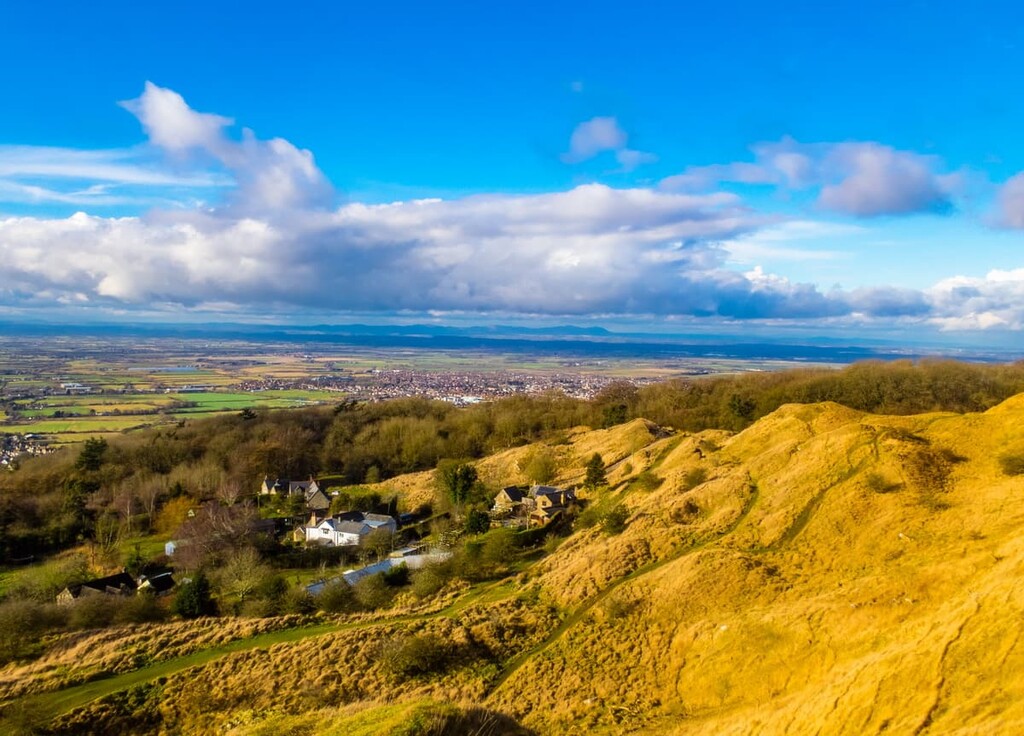
The Cotswolds AONB is located in South West England, where it covers an area of 787 square miles (2,040 square km). Its size makes it the largest of Britain's 46 AONBs, and the third-largest protected area after the Lake District National Park and the Yorkshire Dales National Park.
The Cotswold AONB is spread across 6 counties: Gloucestershire, Oxfordshire, Somerset, Warwickshire, Wiltshire, Worcestershire.
The area takes its name from the Cotswold Hills, a range of picturesque yet modest hills which run from Bath in a northeasterly direction past Banbury. The range starts gently in the Upper Thames before forming a stunning escarpment over Evesham Vale and the Severn Valley.
The Cotswolds are surrounded by several AONBs and national parks, making it a superb area for an extended hiking adventure. The Cotswolds AONB is approximately 30 miles (48 km) east of Wales' Brecon Beacons National Park, 65 miles (105 km) northeast of Exmoor National Park, and 50 miles (81 km) north of the New Forest National Park.
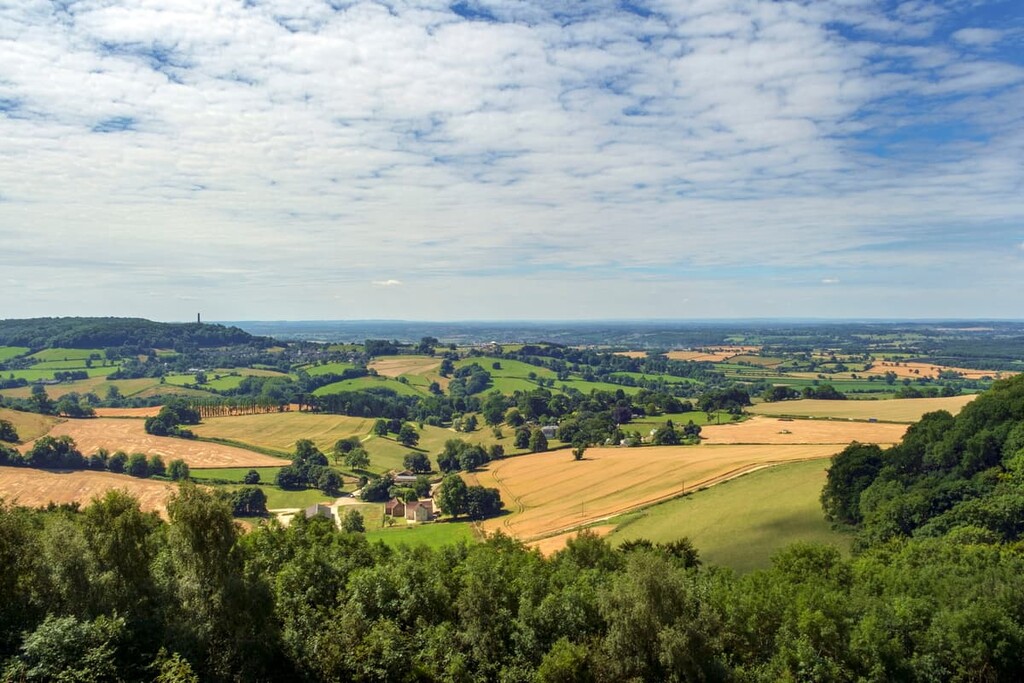
There are several notable cities and towns within or on the boundaries of the Cotswolds AONB, including Bath, Bristol, and Cheltenham. The area is located approximately 70 miles (100 km) west of the capital of the United Kingdom, London.
There are no true mountains within the Cotswold Hills, with only ten hills exceeding 300 m (984 ft) in height. Cleeve Hill is the highest point in the AONB and the county top of Gloucestershire. It is located approximately 5 miles northeast of Cheltenham.
Cleeve Hill forms part of the Cotswold Edge, one of the Cotswold Hill's best-known geological features. The escarpment runs for 52 miles (84 km), and was created by an uplift of the region's large limestone layer. Geologically, this rock formation is known as a cuesta.
The Cotswold Hills are composed of Jurassic limestone, which dates back between 140 and 210 million years. The hills form part of an outcrop that runs from the Jurassic coastline of Dorset up through Yorkshire.
The limestone is oolitic, meaning it's made from small round grains. This limestone formed in warm tropical oceans somewhere near what is now the US state of Florida and the Caribbean Sea. The rock moved to its current position by shifting tectonic plates around 150 to 200 million years ago.
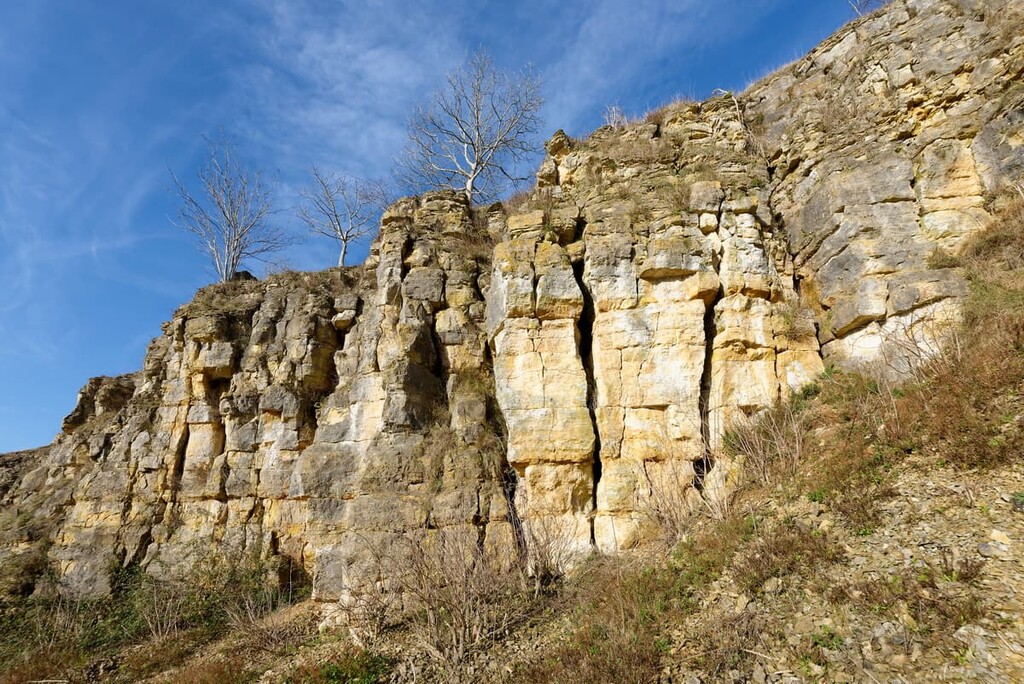
Many of the villages and towns in the Cotswolds are constructed out of Jurassic limestone. When weathered, the limestone turns into a beautiful honey color, adding to the charm of many of the region's historic settlements.
The area's unique formation has led certain areas to be designated as Sites of Special Scientific Interest. One example is the areas around Leckhampton Hill (300 m/984 ft), which has the thickest and most exposed sections of Inferior Oolite rocks in the country.
Over the last century, the Cotswolds have undergone significant agricultural development, leading some experts to state the area is going through an ecological crisis.
In the 1930s, 40 percent of the Cotswolds' grasslands were covered in ancient wildflowers. These grasslands accounted for a substantial percentage of England's wildflower population and provided habitat for an array of insects, birds, and mammals.
Today, only 1.5 percent of the Cotswolds' grassland habitats remain, covering approximately 7,400 acres (3,000 hectares). Despite its dwindling size, this area still accounts for half of Britain's limestone grasslands.

The grasslands are home to a number of orchid and butterfly species, notably the Adonis blue butterfly, which had been missing from the area for 30 years. It is also one of the few areas in Britain where Duke of Burgundy butterflies are abundant. Notable flora visible across the grasslands include thyme, wild marjoram, and harebell.
Roughly 10 percent of the AONB is composed of woodlands, predominantly semi-natural beech. These woodlands and the surrounding streams act as a habitat to many of the Cotswolds' smaller mammals, including brown hares, water voles, and otters.
While bird species have been in decline across the Cotswold AONB, the Farmland Bird Project made an effort to bring some species back to the area. For example, the project worked with local farmers to increase the population of several species that have all but disappeared since the 1970s, including turtle doves, skylarks, and yellow finches.
The Cotswolds are also home to a large population of roe, muntjac, and fallow deer. The size of the population is causing problems, so the AONB now encourages culling of the local herds. As well as damaging ecosystems through overgrazing, deer-related car accidents are common in the Cotswolds. Motorists are advised to use caution when driving through the area.
The earliest evidence of human settlers in the Cotswolds date back to the Neolithic period between 5,000 to 8,000 years ago. There are several neolithic burial mounds around the Cotswold Edge, including Belas Knap Long Barrow, which is thought to date back to 4,300 BCE.
Following the arrival of the Romans in the first century, many Anglo-Roman settlements appeared across the Cotswolds. One of the most famous Roman structures in the South West is the Roman Baths of Bath, which were built around 70 CE.
Throughout the medieval period, the Cotswolds were famous across the continent for producing some of the world's finest wool. This booming trade was due to a breed of sheep known as the Cotswold Lion, as well as the area's rolling hills being perfect for grazing sheep.
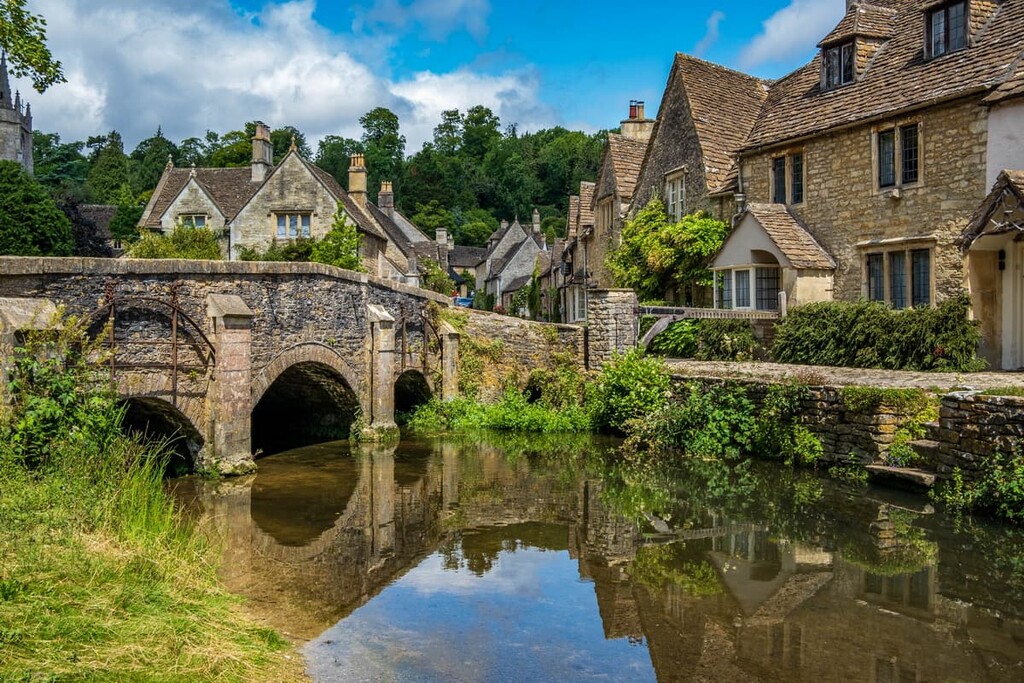
During the seventeenth century, the Cotswolds were the site of several important battles during the English Civil Wars due to the hills' strategic advantage. The first battle of the Civil War took place on the northern edge of the Cotswolds on October 23, 1642. Many of the area's villages, like Broadway, Stow-on-the-Wold, and Bourton-on-the-Water, still have strong connections to the Civil Wars.
The modern-day Cotswolds are dominated by farmlands; however, agriculture is now the third-biggest employer in the area after tourism and services. The Cotswolds were designated an AONB in 1966. The area is managed by the Cotswold Conservation Board.
The Cotswolds are home to approximately 139,000 residents. Around 38 million people visit the Cotswolds each year to hike through the hills and explore the golden villages.
Medieval castles, verdant rolling hills, and some of the prettiest villages in England await hikers in the Cotswold AONB. Read on to find out about some of the best hiking areas and trails.
Hiking up Cleeve Hill (317 m/1,040 ft) from Winchcombe is one of the most rewarding walks in the Cotswolds AONB. The walk will take you to the highest point in the Cotswold Hills. You'll also pass one of the oldest Neolithic sites and one of the grandest castles in the AONB.
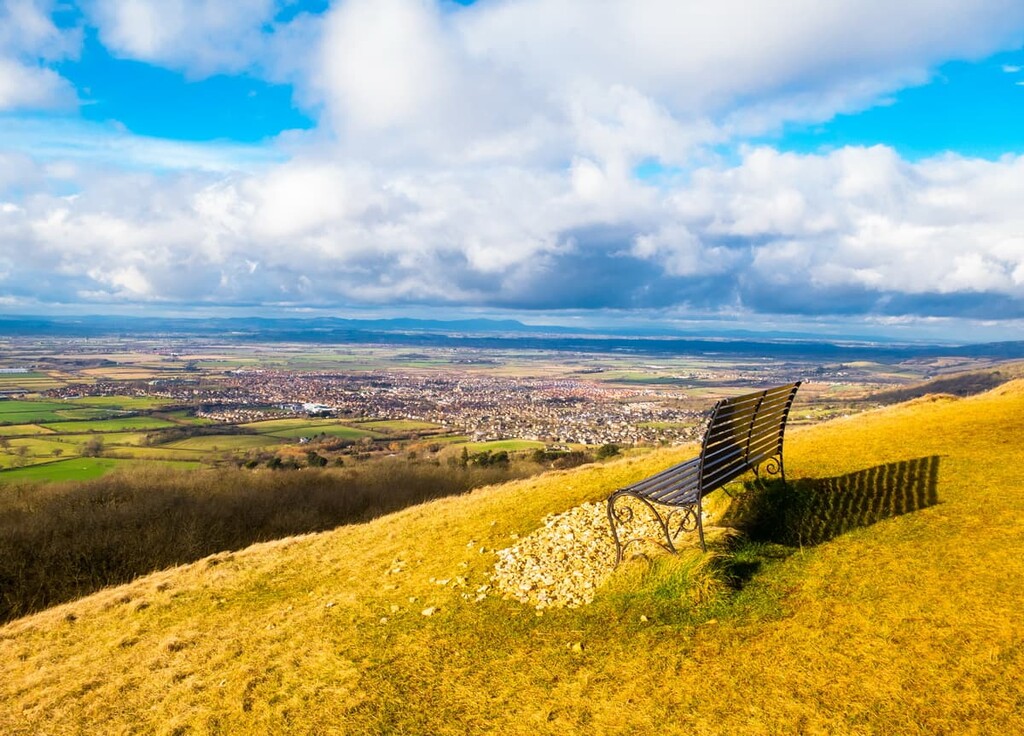
Due to its modest height and clear paths, anybody who exercises regularly should find a trip up Cleeve Hill to be relatively casual. The route from Winchcombe is a 5.5-mile linear walk that ascends 354 m (1,200 ft) and takes around 6 hours to complete.
You'll start the walk by heading from the village towards Cleeve Common, with the majority of the walk following the Cotswold Way south.
The route is signposted and easy to follow due to its popularity. You'll first reach the gardens of the lavish fifteenth-century Sudeley Castle, which King Henry VIII and Anne Boleyn once visited. The castle is also open for tours. Then, you'll pass by one of the oldest historic sites in the Cotswolds, the Neolithic Belas Knap Long Barrow.
From your last stop at the trig point atop Cleeve Hill, you'll be provided with sweeping views of Cheltenham and Gloucester. Eagle-eyed observers will even be able to pick out Gloucester Cathedral and the Cheltenham Racecourse.
The Cotswolds AONB's most prominent point, Bredon Hill (301 m/987 ft), sits isolated at the heart of the Evesham Vale. Due to its flat surroundings, Bredon Hill affords panoramic views of the Cotswolds. It's also topped with the eighteenth-century Parsons Folly tower, as well as the remains of an Iron Age fort called Kemerton Camp.
As with Cleeve Hill, Bredon Hill is a casual walk with a simple ascent. Some parts of the route cross fields and follow muddy bridleways, so wear hiking boots. You can pick up the trail from the village of Elmley Castle before cutting across a field towards Hill House Farm. The walk is 5.5 miles, ascends 248 m (820 ft), and takes 3 or 4 hours.
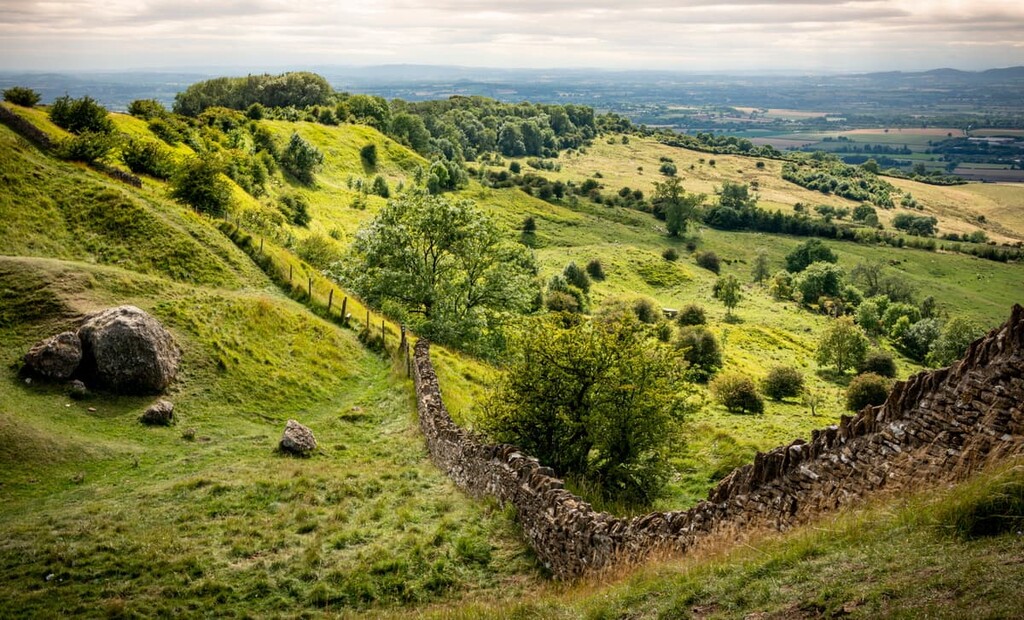
You'll first come across the Iron Age Kemerton Camp, which is well worth exploring. Then you'll walk along the hill's plateau to Parsons Folly for uninterrupted views across the Evesham Vale. The best way to descend is to follow the Wychavon Way.
Adorned with perhaps the finest folly (an ornamental building that serves no real practical purpose) in the Cotswolds, Broadway Hill (223 m/731 ft) is a favorite among local hillwalkers. The Gothic Broadway Tower stands 20 m (65 ft) high atop Broadway Hill and is a popular tourist attraction, hosting regular exhibitions, as well as a gift shop and cafe.
The tower was constructed at the turn of the nineteenth century as a beacon for Lady Coventry. It was also a favorite spot for renowned writers Dante Gabriel Rossetti and William Morris. Ensure you climb to the top of the tower, from where you can see 16 counties on a clear day.
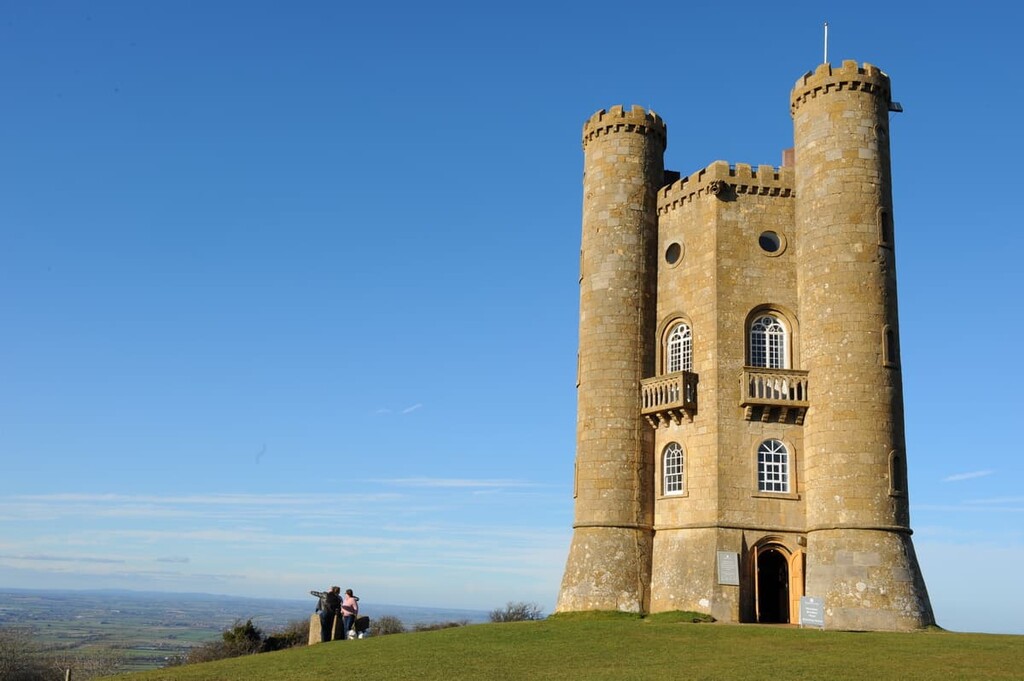
There are a couple of popular routes up to Broadway Tower. You can either take the long way from Chipping Campden following the Cotswold Way or take the direct route from the car park in Broadway. The direct route is 5 miles, ascends 236 m (780 ft), and takes 3 or 4 hours.
The walk up Broadway Hill is short but steep so bring suitable footwear. Due to its short length, this hike is manageable for most people. From the church at Broadway Court the trail is signposted, making it difficult to get lost. To descend, follow the Cotswold Way to the north of the tower and follow it most of the way back to the village.
Casting a shadow over Chipping Campden, Leckhampton Hill (300 m/984 ft) provides excellent vistas of the northern Cotswold Hills. The hill is instantly recognizable due to the Devil's Chimney, a natural limestone column that sits atop the summit. The hill is also a Site of Special Scientific Interest due to its exposed Inferior Oolite rock.
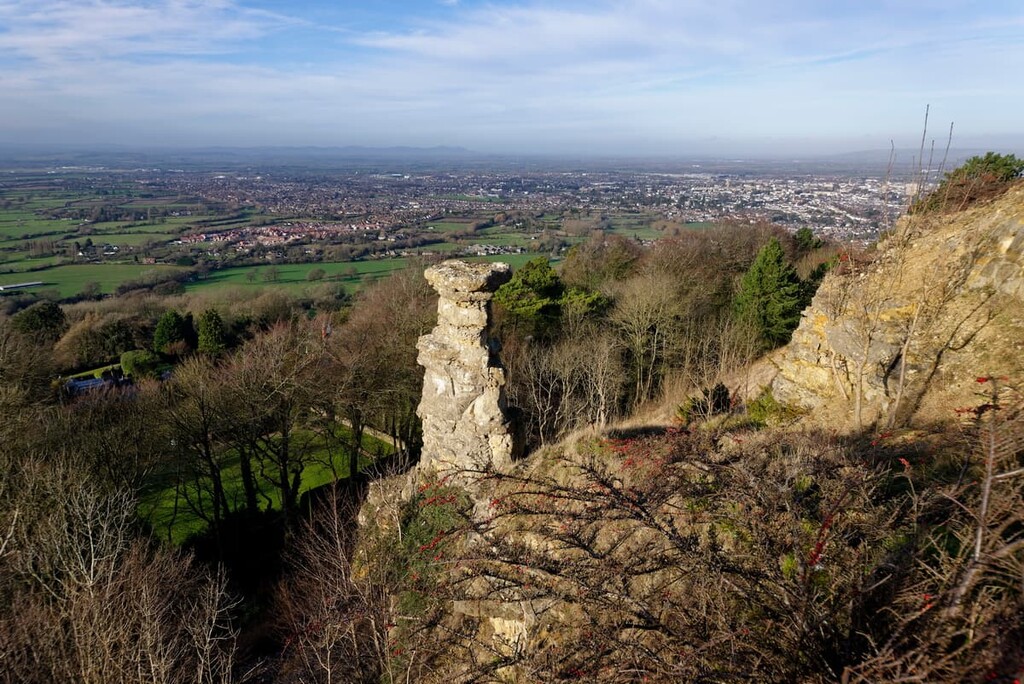
The most popular way of climbing Leckhampton Hill is on the Cotswold Way. The route also includes the neighboring Hartley Hill (285 m/935 ft). You can pick the trail by parking at the pub at Seven Springs. Head towards the roundabout and keep left on the marked Cotswold Way to start the walk.
The looped walk up Leckhampton Hill is 4.5 miles (7 km), ascends 297 m (974 ft), and takes around 3 hours. The route first takes you across the scenic Kings Common Cross, passing an Iron Age fort that dates back to about 250 BCE. Then, you'll pass over the slopes of Hartley Hill to Leckhampton Hill.
After taking in views of the Severn Vale and Chipping Campden, you'll pass the old quarry building, where the path splits in seven. To descend, follow the path straight down the hill, signposted "Public footpath/Leckhampton Hill Walk 8."
Dover's Hill (225 m/728 ft) offers hikers some superb views and intriguing insight into local history. The hill was named after Robert Dover, who founded the Cotswold Olimpick Games, which started in 1612 and was the precursor of the modern-day Olympics (besides the Olympic Games in Ancient Greece, of course).
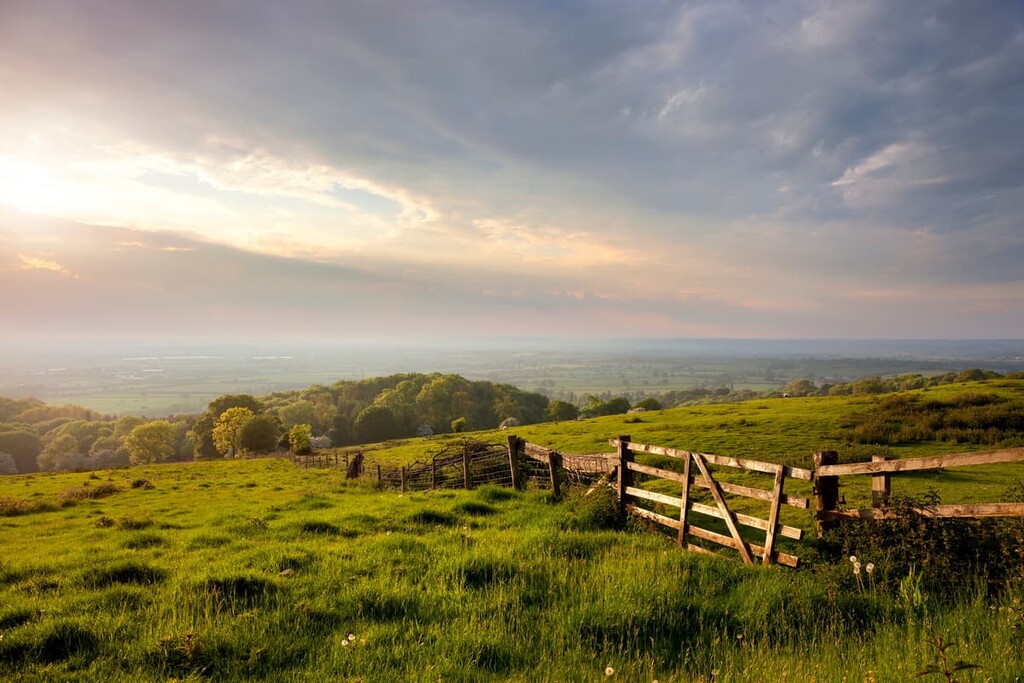
This circular hike up Dover's Hill is around 4 miles (6.4 km), ascends 210 m (689 ft), and takes 2 hours. The walk is straightforward and follows the Cotswold Way from Chipping Campden. Just follow the signposts from High Street to begin the hike.
You'll first pass through the scenic Lynches Wood, with its ash, hazelwood, and sycamore trees. As you exit the woodlands, you'll make a short ascent to the top of Dover's Hill. Follow the path around to return to your starting point.
The Cotswold Way is a long-distance walk that takes you on a meandering tour of the best of this stunning natural area. The trail starts on the northern edge of the AONB in the scenic village of Chipping Campden and takes hikers on a 102-mile (164 km) trek to the Roman city of Bath.
Undoubtedly one of the finest of the UK's National Trails, the Cotswold Way is an undulating path that takes you over 17 hills, including many of the best in the Cotswolds, like Cleeve Hill (317 m/1,040 ft), Leckhampton Hill (300 m/984 ft), Coaley Peak (232 m/761 ft), and Stinchcombe Hill (218 m/715 ft).
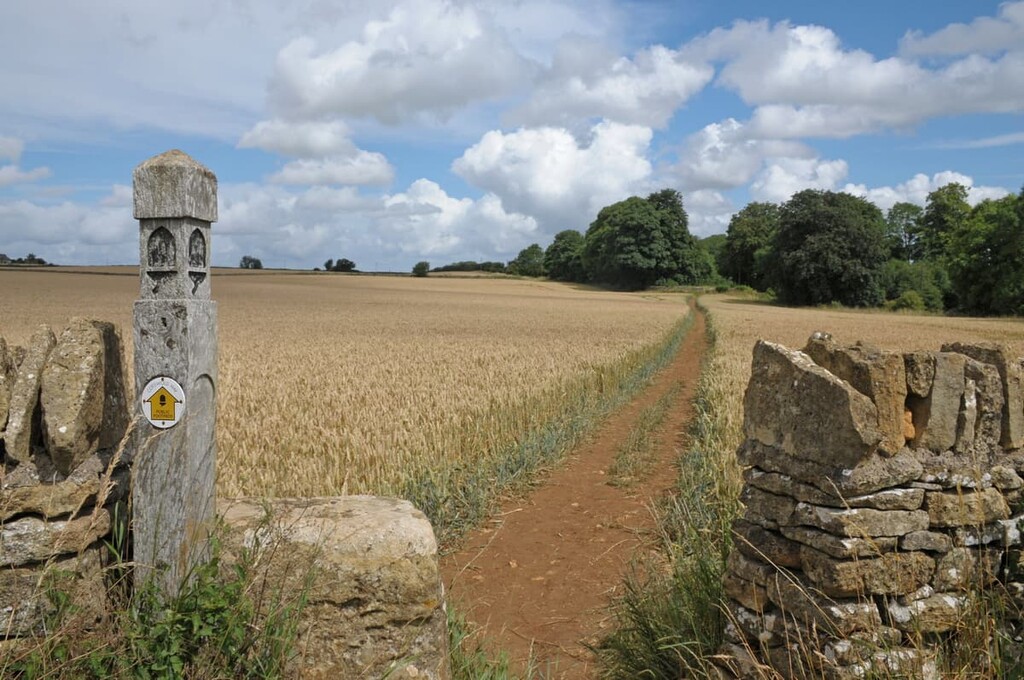
As you pass over the Cotswold Edge, you'll be treated to some beautiful views to the north and west. Near Gloucester, you'll get to enjoy views of the Severn Estuary and the Sharpness, with Gloucester Cathedral also visible.
Some of the best views to the west are of the Black Mountains in the Brecon Beacons National Park. Visible to the west of most of the walk is May Hill (308 m/1,010 ft) and the Malvern Hills.
Despite plenty of steep inclines along the route, the Cotswold Way is manageable for most frequent hikers. The walk is usually completed in six to ten days, depending on your fitness levels and how long you want to spend exploring the Cotswolds' scenic villages.
You won't be short of places to stay along the Cotswold Way, with the trail passing through some particularly charming settlements. Popular options for accommodation include Broadway, Wotton-under-Edge, and Painswick. A stone disc at the western doors to Bath Abbey marks the end of the way.
Containing some prettiest villages and towns in England, the Cotswold AONB isn't short of idyllic places to spend the night. Read on to find out about some of the area's main settlements.
Situated roughly 8 miles (12 km) west of the Cotswold is one of England’s largest urban areas, Bristol. Separated from South Wales by the Severn Estuary, Bristol is perfect for travelers looking to stay close to the Cotswolds, while still having plenty of world-class attractions to enjoy.
When you’re not off exploring the Cotswolds, cross the Clifton Suspension Bridge, step aboard Brunel’s SS Great Britain, or tour the collection at the Bristol Museum and Art Gallery. You shouldn’t have any trouble booking a room in Bristol, with dozens of hotels including the Bristol Hotel, the Future Inn, and the Hampton waiting to welcome you to the region.

The Roman city of Bath is well-worth visiting during your visit to the Cotswolds. Sat on the southern edge of the Cotswold AONB, Bath is a World Heritage Site, famous for its first-century Roman Baths and Georgian architecture. Bath is a tourist attraction in its own right, receiving approximately 1.3 million visitors annually.
Bath acts as the finishing line for the Cotswold Way and is a great place to relax for a couple of days after completing this long-distance trek. You'll also find several classy hotels in Bath, including the Z Hotel, the Parade Park Hotel, and the Macdonald Bath Spa Hotel.
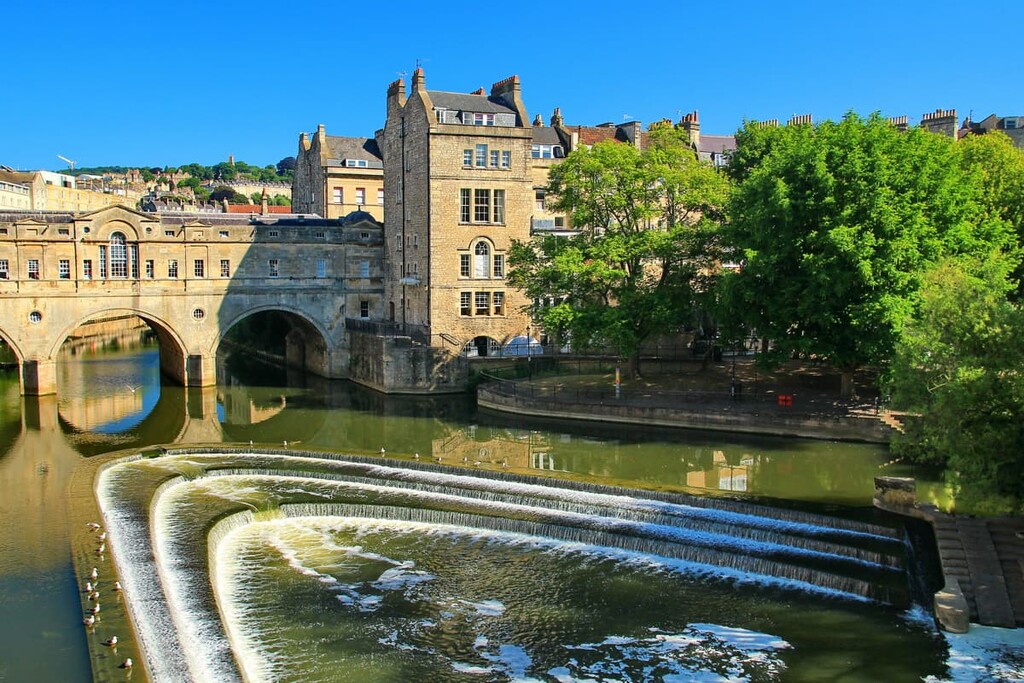
Another major historic settlement perched on the edge of the Cotswolds is the spa town of Cheltenham. There's nowhere better in the Cotswold to soak up local culture, with annual events like the Cheltenham Literature Festival, the Cheltenham Music Festival, and the world-famous Cheltenham Festival.
Located in Gloucestershire, Cheltenham is an ideal base for hikers and is within 5 miles (8 km) of some of the tallest hills in the AONB, like Cleeve Hill and Leckhampton Hill. If you're planning on spending a night in Cheltenham, spend it at the DoubleTree Hilton or the Malmaison.
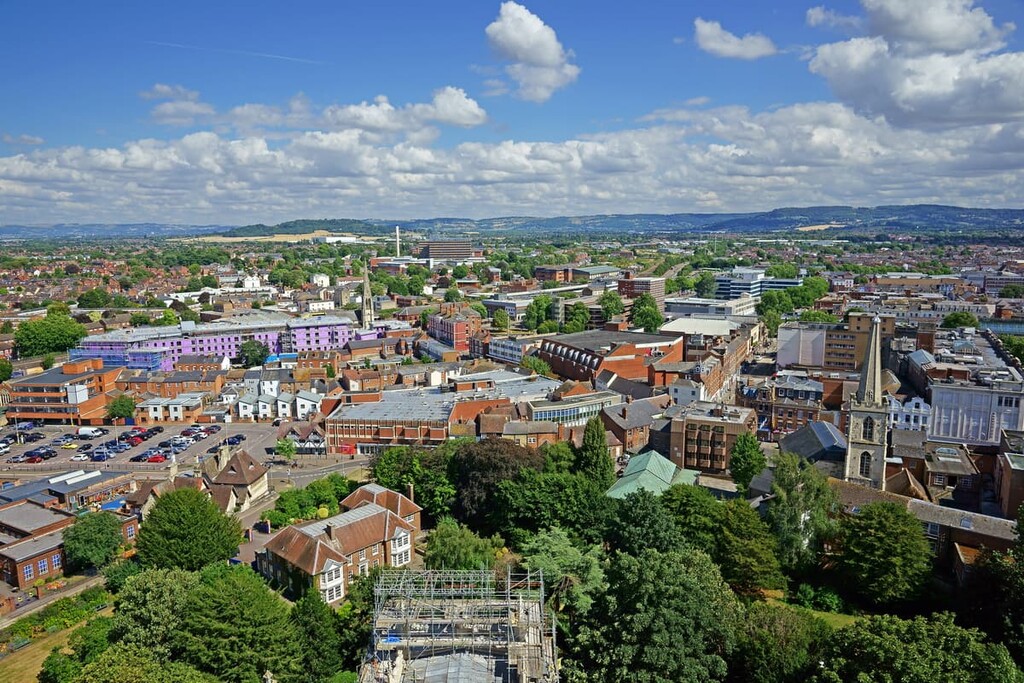
Stroud is the largest town in the Cotswolds AONB. It's considered one of the best places to live in the UK, and with its beautiful countryside and historical attractions, it's easy to see why.
During your stay in Stroud, ensure you tour the seventeenth-century Museum in the Park and plan a picnic atop Coaley Peak. The Cotswold Way also runs just to the west of the town. Some of the best hotels in Stroud include the Bear of Rodborough Hotel and the Amberley Inn.
If you'd prefer to stay in one of the Cotswolds' gorgeous honey-hued towns and villages, consider Chipping Campden. This quaint market town is famous for its association with the local wool trade and hosting its own Olympic Games since 1612.
Chipping Campden is also great for hiking — it serves as the start of the Cotswold Way and is within 5 miles (8 km) of Dover's Hill and Broadway Hill. Popular hotels in Chipping Campden include the Noel Arms and Charingworth Manor.
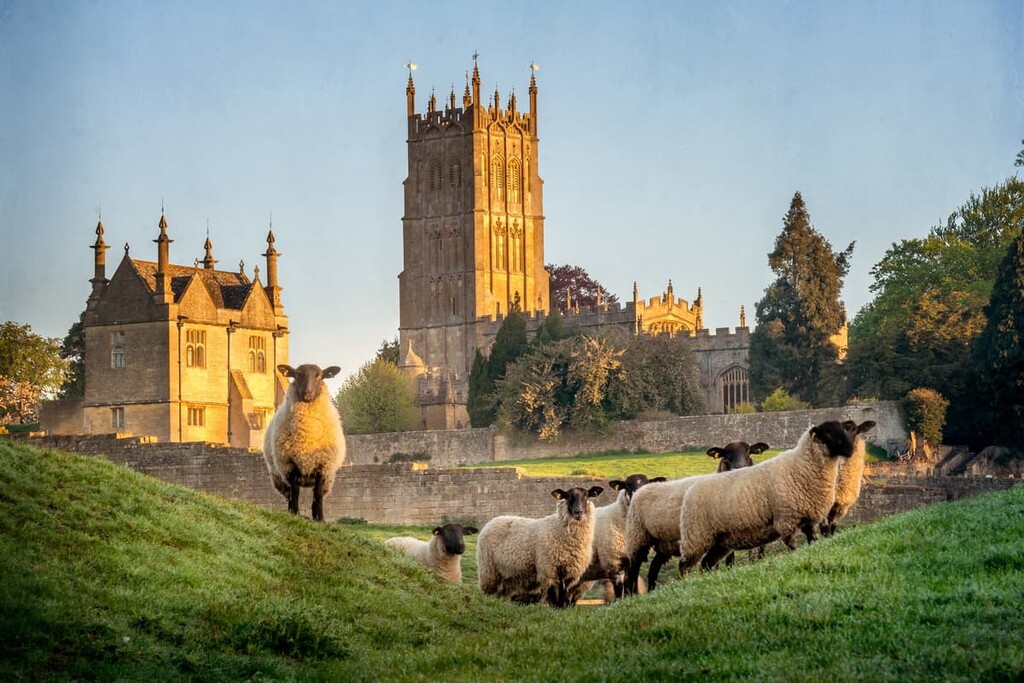
Located at the heart of the Cotswolds, Bourton-on-the-Water is another hugely popular picture-perfect village. Dubbed "the Venice of the Cotswolds," Bourton-on-the-Water is designated a Conservation Area and is home to over 100 historically significant buildings.
Bourton-on-the-Water is perfect if you're planning a family vacation, as it features family-friendly attractions like the Birdland Park and Gardens and the Cotswold Motoring Museum. Hikers looking to stay in Bourton-on-the-Water should check out the Broadlands Hotel and the Chester House Hotel.
Searching for the prettiest village in the Cotswolds? Swing by Castle Combe. This magical village has some of the finest examples of Jurassic limestone buildings in the AONB, with no new homes built in Castle Combe since the seventeenth century.
If you're looking for something unique to do during your stay, watch a race at the Castle Combe Circuit. Castle Combe is also near some minor hills, like Rack Hill (141 m/462 ft) and Gibb Hill (131 m/429 ft). Some of the best hotels in Castle Combe include the White Hart and The Manor House Hotel.
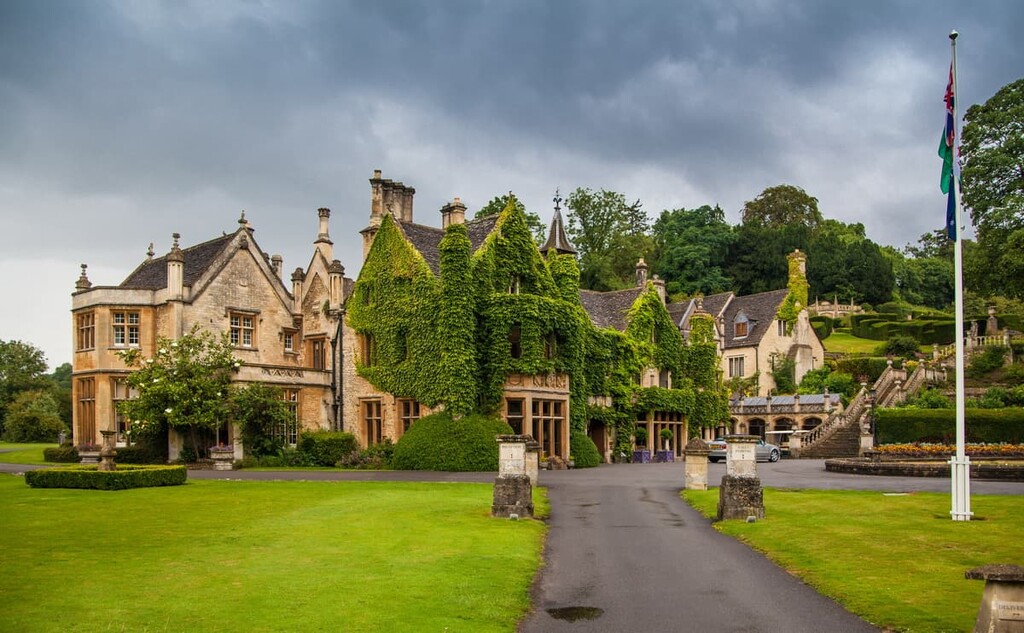
Explore The Cotswolds AONB with the PeakVisor 3D Map and identify its summits.








